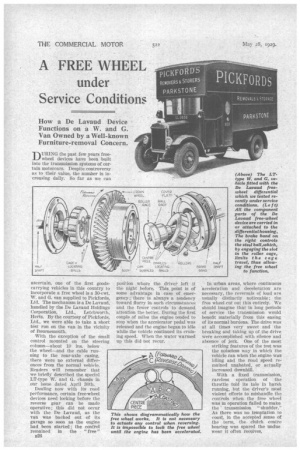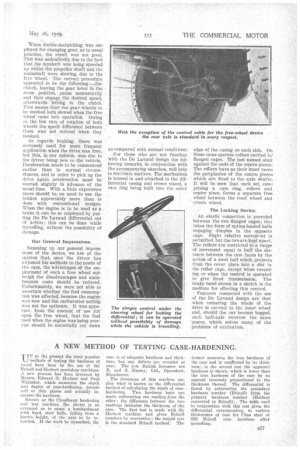A FREE WHEEL under Service Conditions
Page 52

Page 53

If you've noticed an error in this article please click here to report it so we can fix it.
How a De Lavaud Device Functions on a W. and G. Van Owned by a Well-known Furniture-removal Concern.
TIURING the past few years free..L.1 wheel devices have been built into the transmission systems of certain motorcars. Despite controversy as to their value, the number is increasing daily. So far as we can
ascertain, one of the first goodscarrying vehicles in this country to incorporate a free wheel is a 30-cwt. W. and G. van supplied to Pickfords, Ltd. The mechanism is a De Lavaud, handled by the De Lavaud Holdings Corporation, Ltd., Letchworth, Herts. By the courtesy of Pickfords, Ltd., we were able to take a short test run on the van in the vicinity of BOUrnemouth. With the exception of the small control mounted on the steering column—about 10 ins, below the wheel—and the cable running to the rear-axle casing, there were no external differences from the normal vehicle. Readers will remember that we briefly described the special LT-type W. and G.chassis in our issue dated April 30th. Dealing now with its road performance, certain free-wheel devices need locking before the reverse gear can be made operative; this did not occur with the De Lavaud, as the van was backed out of its garage so soon as the engine had been started; the control remained in the "free"
B26
position where the driver, left it the night before. This, point is of some advantage in case• of emergency; there is always a tendency toward flurry in such circumstances and the fewer controls to demand attention the better. During the first couple of miles the engine tended to stop when the accelerator pedal was released and the engine began to idle while the vehicle continued its cruising speed. When the water warmed pp this did not recur.
In urban areas, where continuous 'acceleration and deceleration are . necessary, the reversals of load are usually distinctly noticeable; the free wheel cut out this entirely. We should imagine that in long periods of service the transmission would benefit materially from this easing of its normal burdens. The drive was at all times very sweet and the breaking and taking up of the drive were accomplished with silence and atcence of jerk. One of the most striking features of the test was the noiseless way in which the vehicle ran when the engine was idling and the road speed re;. mained unabated, or actually increased downhill.
With a fixed transmission, careless operation of the throttle told its tale in harsh running, but the driver's most violent efforts to mishandle the controls when the free wheel was in operation failed to make the ' transmission " shudder." As there was no temptation io coast, in the accepted sense of the term, the. clutch centre bearing was spared the undue wear it often receives. When double-declutching was employed for changing gear, as in usual practice, the result was not good. This was undoubtedly due to the fact that the layshaft was being -sPeeded up whilst the propeller Shaft and the mainshaft were slowing, die to the free wheel. The correct 'procedure appeared to be the folloWing clutch, leaving the gear lever in the same position, pause momentarily and then engage the desired. speed, afterwards letting in the clutch. This means that-the geat wfieels to be meshed both slowed when the free wheel came into operation'. Owing to the leow rate of rotation of both wheels the speed difference .betWeEn them was not noticed 'when they meshed. ' , As regards braking, there was • obviously need 'for more frequent application when the drive was free, but this, in. our opinion, was due to the driver being new. to the vehicle. Deceleration needs to be Commenced earlier than in normal circunistances, and in 'order to pick up the drive again acceleration must be started slightly in advance of the -usual time. With a little experience there should be no need to use the brakes appreciably more than -is done with conventional designs. When the engine is to be used as a brake it can be so employed by Putting the De Lavaud differential out of action ; this can be done while travelling, without the possibility of damage.
Our General Impressions. ,
Summing up our general impressions of the device, we are ef the opinion that, once the driver has adjusted his methods to the needs' of the case, theadvantages of the employment of such a free wheel outweigh the disadvantages and maintenance costs should be reduced. Unfortunately, we were not able to ascertain whether the fuel consumption was affected, because the engine was new and the carburetter setting • was not the optimum. It was apparent, from the amount of use put upon the free wheel, that the fuel used when the engine was being overrun should be materially cut down as compared with 'normal conditions.'
For. those whe are net familiar with the De Lavauddesign the following 'remarks, in conjunction with the accompanying sketches, will help to elucidate matters. The mechanism is housed in and attached to the differential casing and crown wheel, a cam ring being built into the outer edge of the casing on each side. On these cams operate rollers carried bj flanged cages. The last named abut against the ends of the centre pieces. The Milers have as their inner races the peripheries of the centre pieces which are fixed to the axle shafts. It will be seen that each set, COMrn prising a cam ring, rollers and centre piece, forms a separate free whbel between the road wheel and crown wheel.
The Locking Device.
An elastic connection is provided between the two flanged cages; thi3 takes the form of spring-loaded balls engaging dimples in the opposite cage. Slight relative movero-Ant is permitted, but the two are kept apart. The rollers are restricted to a range of movement equal to half the distance• between the cam faces by the action of a steel ball which projects froth the cover plate into a slot in the roller cage, except when revert!' ing or when the control is operated to give !fixed transmission. The brake band shown in a sketch is the medium for effecting this control. .
• Features connected with the use of the De Lavand design are that when cornering the whole of the drive is carried to the inner wheel and, should the car become bogged, each half-axle receives the same 'power, which solves many of the problems of extrication.




















































































































